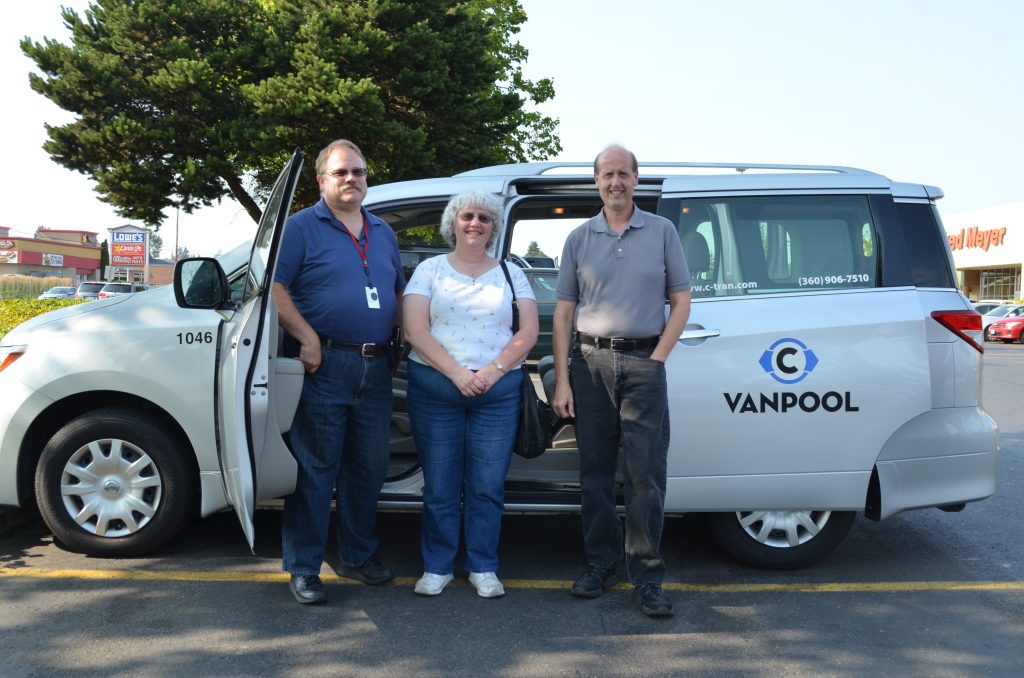Occupation: Service Engineer
How do you usually get to work? How long have you been using this travel option?
Vanpooling is my primary commute method for going to my office.
The van for my vanpool is parked about 10 miles from my house, at a Fred Meyer store, so I make a serious effort to either carpool with my spouse or ride my bicycle to the van.
How long have you been using this commute option?
I’ve been driving the vanpool for about 18 years. I helped set up the first vanpool to Swan Island back in 2002. I started driving that vanpool around 2005.
I’ve been using some form of alternative commuting for almost 40 years – bicycle, carpool, or bus. The lack of student parking at UCLA forced me to use alternative modes of transportation.
How far is your commute? How long does it take you each way?
Shortest distance from Vancouver to Swan island for my vanpool is approximately 16 miles. On a good day, the commute to the office takes 30 minutes, and about 40 minutes coming home. On a bad day, well, that’s why I have riders ;=}
From my house to the van is about 10 miles. When bicycling, I plan for an hour commute each way. Carpooling is faster at about 20 minutes each direction.
What is your favorite thing about your commute?
Except when bicycling, I am never alone on my commute. Conversations on the vanpool have covered a wide range of topics, and most are not work-related.
What is a challenge of your commute? How have you overcome that challenge?
The biggest challenge I’ve had to deal with over the years is recruiting new riders to keep the vanpool going. There used to be 4 vanpools to the Swan Island area, and now, mine is the only one that remains.
I think I’ve heard every excuse about why alternative commuting methods won’t work – cost, inconvenience, time “lost,” family issues. I challenge each prospective rider to give the van a try-out, and I seek to comprehend their concerns and to find ways to address the concerns.
And I have had enough personal experiences over the years to provide a few personal examples of how a vanpool can work.
Tell us a favorite or interesting commute story.
I don’t normally think of the vanpool as a matchmaking service. Shortly after I started driving the vanpool, a young lady and young man that were riding my van became engaged, and later married.
How does your commute help you save time and/or money?
The cost savings are relatively easy to pencil out. First, there’s fuel cost: I can identify the savings when I only drive 10 miles to the van, instead of 22 miles to my office. Next, there’s insurance: my car insurance carrier increases my insurance about $50 per 6 months if my daily round-trip mileage is 44 miles instead of 20 miles. And while the van costs me $55 a month, I compare that against fuel prices, and figure that I’m ahead by about $100 a month.
I admit that I don’t save time by using alternative commute methods, instead, I have learned to use my time differently. When I’m driving the vanpool, I use the time to socialize with my riders (occasionally talking about a work issue). When I’m bicycling, I spend more time on the bike in a day (2 hours) than I would at the gym (1 hour), though that extra hour is time that I am unwinding from workday stress.
Where I really benefit is by having well-defined bookends for my workday. Not that work does not occasionally follow me home – instead, I have well-defined office hours and any meetings scheduled outside of that time either need to be phone calls, or need to wait until I’m home.
How does your employer help accommodate your commute option?
Daimler Truck currently subsidizes my vanpool for any direct employee that wants to ride. (Contract employees and employees of other businesses on Swan Island are not covered.)
In addition, Daimler Truck has set up a Transportation Reimbursement Incentive Program, which allows me to deduct the monthly vanpool fare from my earnings before income taxes.
Finally, in case of an emergency, Daimler Truck provides electric SMART cars for employees to check out.
That’s in addition to having flexible work hours.
Do you have any advice for someone looking to use a climate-friendly commute option?
BE FLEXIBLE! You must be willing to adapt a little. Even with a carpool, there are some simple trade-offs that need to be hammered out early.
As one example, my commute and my spouse’s commute do not align perfectly. On days that we carpool, one of us may wait for the other for up to a half hour in the afternoon. That’s a perfect time to shop (especially since we meet at a Fred Meyer store), or relax and unwind from the day’s work.
